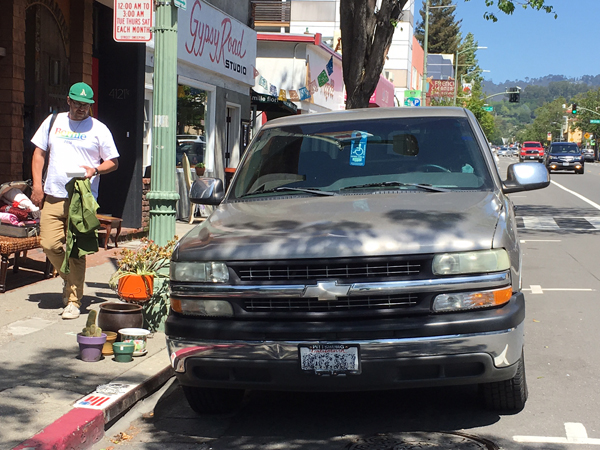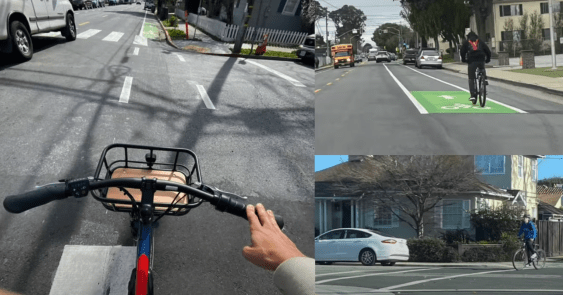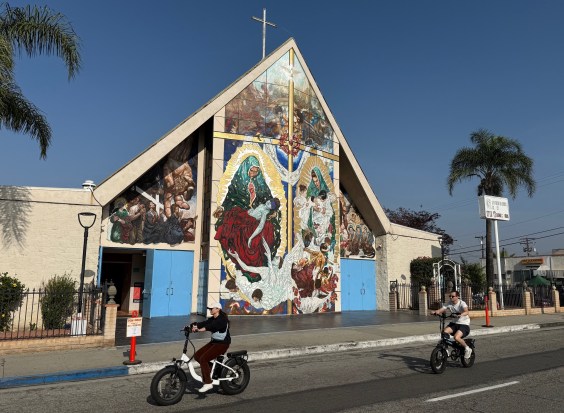
Assemblymember Mike Gatto (D-Los Angeles) has introduced a bill that would require some people with disabled parking permits to pay, rather than park for free as long as they want. If it works, A.B. 2602 could free up parking spots for every driver, including disabled people who most need them. It could also potentially discourage some driving by people who now park free for as long as they like.
As currently written, after several amendments, Gatto's bill would separate the idea of “free parking” from “access for disabled individuals.” It would create a two-tier system whereby people could obtain disabled placards the usual way and use them to park in blue parking zones on the street and in parking lots. But they would no longer be allowed to park for free at metered parking spots.
Some people would still be allowed to park without paying, but they would have to meet certain conditions—for example, if they can't reach a parking meter or handle coins—and they would have to apply for a special sticker to put on the placard.
The bill is one among several previous efforts to deal with cars that sport disabled parking placards taking up a high percentage—sometimes all—of the street parking spaces in high-demand areas. “Parking placard abuse” has been decried for years, but it's been difficult to figure out a solution in part because it's difficult to get data on how much fraud there actually is.
What is certain is that as long as drivers with placards can park for free for as long as they want, and enforcement is ineffective, the incentive to “abuse” the placards is pretty high.
Some have called for enforcement to be stepped up, but even this isn't as simple as it seems. This bill's first draft called for stricter oversight by the DMV and more frequent certification of eligibility. But the DMV already has procedures to prevent the misuse of placards, including a system to weed out placard holders who have died.
Other solutions have been floated, including increasing “sting” operations, or refining the list of medical practitioners who can certify someone for a disability, or creating stricter regulations about what counts as a qualified disability. All of those solutions have deep flaws as well. Many people have disabilities that aren't that obvious, and it's not pragmatic to chase down and question people who don't “look” disabled. Clamping down on medical practitioners would shift the onus of enforcement to overburdened medical staff—whose primary, and conflicting, interest is, and should be, their patients' well-being.
According to the Assembly Transportation Committee analysis [PDF], there isn't a lot of data about exactly how much placard abuse there is, nor what form it takes. What everyone “knows” is that there are a lot of disabled placards out there, and they are taking up a lot of parking spaces, and something needs to be done.
It's a sticky issue. San Francisco convened a working group to study it several years ago, when the city was rolling out its SFPark program and realized the large number of disabled parking placards was hampering its effectiveness. The Shoupian program sought to free up parking spots by pricing them based on demand, but demand was difficult to ascertain when so many parking spots were filled by drivers that didn't pay and didn't move. Participants in the working group included disability advocates and planners, and the group concluded [PDF] that the solution was to charge people to park. But as a city San Francisco was powerless to fix the problem, because current state law prohibits charging disabled people for parking.
Meanwhile disability rights advocates have actively opposed changes in current law, calling instead for more enforcement and saying that access to parking is a civil rights issue.
“We recognize that parking is a privilege,” said Anthony Goldsmith with the Californians for Disability Rights. “But it's a privilege that ameliorates civil rights barriers.”
“We're not 'Californians for Free Parking',” he said of his group. “I understand the idea [behind the bill], that a person with a disability with no reasonable reason not to pay for parking should do so. Our concern is that this law doesn't do away with the intent of existing law, which is to ameliorate barriers in streets and parking facilities for people with disabilities.”
He pointed out that many cities still have old parking meters that require coins and lack curb cuts that allow people to more easily reach meters. The bill was amended in part in response to similar critiques, and Assemblymember Gatto has said that he is committed to working with interested groups to craft a bill that works for everyone. Goldsmith acknowledged that “conceptually, it could work, as long as the categories of those who continue to get this privilege are broad enough to not negatively impact people with disabilities.”
“I think it's going in a good direction at this point,” he said. “Hopefully we'll come to a resolution.”
The first draft of Gatto's bill would have allowed local jurisdictions to eliminate the free parking after a public process, but that would have created a patchwork of confusing local differences. Now, with the creation of a two-tier system, the bill comes closer to practices that have met with some success in Illinois and Michigan. Even so, it's not a silver bullet. San Francisco recognized that, in addition to eliminating free parking, it would need to increase the number of blue parking zones to make sure there was enough parking for people who need it. And a two-tier system may be just as ripe for abuse as the existing one, especially if one of the problems is counterfeit placards.
In addition, it will be tricky to find the sweet spot between being too restrictive and too broad. Too restrictive, and some disabled people will be severely affected. Too broad, and there isn't much difference between a two-tiered system and the current one.
A.B. 2602 passed the Assembly Transportation Committee on Monday with ten votes in favor and none opposed.





